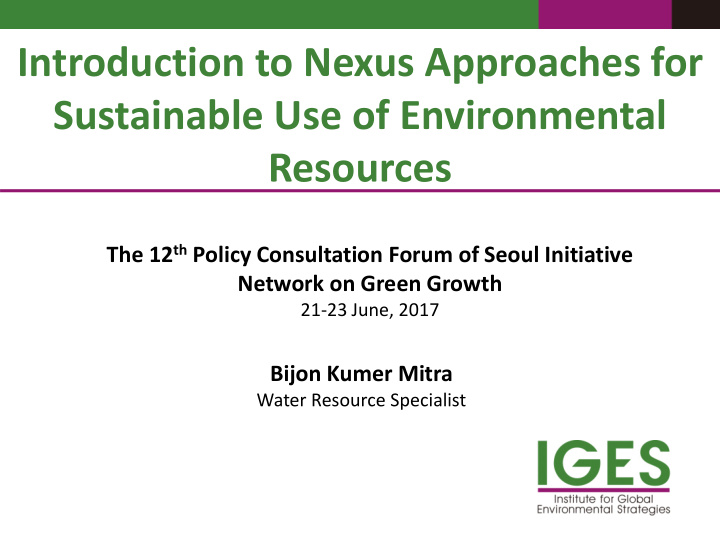



Introduction to Nexus Approaches for Sustainable Use of Environmental Resources The 12 th Policy Consultation Forum of Seoul Initiative Network on Green Growth 21-23 June, 2017 Bijon Kumer Mitra Water Resource Specialist
Millennium Development Goals (MDGs) to Sustainable Development Goals (SDGs) 2 2
Three shocking statistics for Asia and Pacific Region Food 512 million undernourished live in Asia (FAO, 2014) Nearly 1.7 billion people in the Asia and Pacific Water region do not have access to improved drinking water (UNESCAP, 2015) Energy Nearly 350 million people have no access to modern form of energy (IEA, 2011) 3 3
where we are heading for? Food, water and energy security are not going to be ensured in Asia Food Food demand + 50% Risk to Security of Supply Water Energy 40% Annual elec. shortfall by demand +5% 2030 Challenges Inadequate legislation Resource intensive Finance Population and enforcement lifestyle Uncoordinated sectoral Economic Resource intensive Knowledge gap planning growth production system 4 4
Inherent interdependent nature of water energy and food security Agriculture accounts about 80% of water withdrawals Water security Food security Population growth, urbanization, climate change About 7% of total Indian agricultural world’s energy sector accounts 18% of consumption is the total electricity accounted for water consumption (CWC, delivery (Hoffman, 2010) 2004) Incentives to bio-fuel production By 2050, Indian energy sector’s are the cause of rising global water demand will reach to 90 Energy security food price, put burden on the BCM, which is about 8% of total poor (World Bank, 2008) utilizable water (IGES, 2013) 5 5
Network of Interlinkage of FWE Targets in SDGs Weitz et al., 2014 6 6
WEF Nexus Opportunity Areas Accelerate access Increase policy coherence Create more with End waste minimize less losses Mobilize consumer Value natural influence infrastructure 7 7
Nexus thinking and nexus debate are gaining attention in policy and academic circles Dresden nexus conference NC Nexus Conf. UN-ESCAP published The status WWDR-5 WFEN in AP on WEN. Bonn Nexus conference Energy was acknowledged as pillar of Nexus at Kyoto World Water Forum FEE nexus conf. in Brazil UNU FE Nexus programme 2017 2011 2013 2014 1983 1984 2003 8 8
How is the nexus approach different from IWRM WEF Nexus IWRM Priority Equal priority to all Tends to prioritize a particular sectors sector, i.e. water Principle Integrated policy Good governance principle solutions principle Participation Promote collaboration Stakeholder involvement in through multi- decision making stakeholder platform Decision making Environmentally and Efficient allocation and economically rational equitable access decision making Sustainable Resource security Demand management development 9 9
Nexus is not explicitly reflected the major agreements, but critical for country actions • Each country is primarily responsible to make implementation plan of sustainable development • Current unilateral sectoral approach, causes unintended trade-offs and conflicts among relevant sectors or areas, will hindering sustainable development • The country will be the main sufferer, if it fails to address how the efforts to attain sectoral goal and targets would effect each other 10 10
Conflict of interest over water (Case of India) In Madhay Pradesh, power Water stress level cuts was made to alleviate Water scarce the water shortage in the Water stressed region in 2006 (Source: The Moderate water availability Hindustan Times, 2006) Water abundant Parli thermal power plant in In Orissa State, farmers Maharashtra were shut protested the increasing rate down because of severe of water allocation for water shortage in the thermal power and industrial Marathwada region (NDTV, use (UNEP Finance Initiative, 2013) 2010) Opposition to Adani power In Kerala, power cuts projects is growing in local ordered to deal with water community due to threats to scarcity in 2008 when drinking water and irrigation monsoon rainfall was 65% water availability (The Times less than normal (Source: of India, 2011) Thaindian News, 2008) 11 11
Water supply-demand gap scenario- case of India 1000 No surface water left to meet additional demand beyond 2040 800 Surface water resources Billion Cubic Meter Energy 600 Industry Agriculture 400 Domestic 200 Total surface water demand Available surface water 0 2010 2030 2050 Note: Generally, Thermal power plants use surface water for its cooling 12 12
Policy intervention to restrict water use for thermal power plants-Case of India Need approx. 3 billion USD investment (Source: Bosh, 2016) Source: Mitra et al., 2016 13 13
Water scarcity mitigation options in energy sector Gradual transition to more water efficient cooling technology options 30000 2010 2030 2050 30000 2010 2030 2050 25000 25000 20000 20000 MCM MCM 15000 15000 10000 10000 5000 5000 0 0 S1 (BAU) S3 S1 (BAU) S2 S1:25% of the thermal power capacity will continue with open loop cooling system S2: All open loop system will be phase out by 2030 S3: open loop cooling system will be replaced by dry cooling system by 2030 14 14
Potential of irrigation WUE improvement in India 15 15
Economic implication of WUE improvement in South Asian countries 12 Bangladesh India Pakistan 10 8 Billion USD 6 4 2 0 10% WUE 20% WUE 30% WUE 10% WUE 20% WUE 30% WUE Investment GDP gain Source: Prepared based on Taheripuri et al. 2016 16 16
Required billions dollars investment for 20% irrigation WUE in South Asia Save 102 BCM water Save 82000 GWh electricity Reduce CO2 emission by 72 million tons GDP gain by 6.6 billion USD 17 17
Rearrangement of agricultural subsidies can generate necessary investment cost × 18 18
Build up partnership can promote positive nexus 19 19
Enabling Framework for Operationalization of “Nexus Approach” Regulate/pr Regulations omote and policy nexus smart instrument Coordination investment of sectoral strategies Joint visioning and shared goals 20 20
Thank you very much For further contact: Bijon Kumer Mitra Water Resource Specialist Institute for Global Environmental Strategies, 2108-11 Kamiyamaguchi Hayama, Japan 240-0115 E-mail: b-mitra@iges.or.jp
Recommend
More recommend